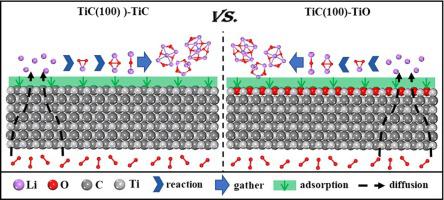Applied Surface Science ( IF 6.3 ) Pub Date : 2021-07-28 , DOI: 10.1016/j.apsusc.2021.150785 Xiaoping Yi 1 , Xunliang Liu 1, 2 , Kai Jiang 1 , Ruifeng Dou 1, 2 , Zhi Wen 1, 2 , Wenning Zhou 1, 2

|
TiC has attracted tremendous recent attention in lithium-oxygen batteries as a means of reducing the irreversible accumulation of by-products (i.e., Li2CO3) on the air cathode. However, TiC is intrinsically reactive to oxygen under ambient conditions, and its stability is completely determined by the surface overlayer. Herein, the catalytic effects of oxide overlayer (TiO) on adsorption mechanism, reaction path, and growth morphology of lithium oxides were comprehensively elucidated using periodic density functional theory calculations. The results indicate that the TiO overlayer on the surface of TiC(100)-TiO enhances the adsorption of lithium oxides. As compared to the disproportionation reaction, the lithiation reaction is the primary contributor to the formation of Li2O2 and Li2O on TiC(100) surface. Interestingly, the oxidized TiC(100)-TiO performs better in inhibiting the generation of undesirable Li2O. Analysis demonstrates that the discharge performance is not only related to the widely known morphology and size of product but also to the adsorption of (Li2O2)n clusters on the TiC(100) surface. The electronic structures of (Li2O2)n clusters on TiC(100)-TiC and TiC(100)-TiO surfaces have been examined to study the influence of TiO overlayer on the conductivity of accumulated products, which helps explain the innovative discovery of the experiment that TiC has excellent performance in improving the cycle ability of lithium-oxygen batteries. Our results promote the understanding of the ORR mechanism on TiC surface and provide theoretical guidance for the design of efficient and stable air cathodes for lithium-oxygen batteries.
中文翻译:

TiC 表面氧化物覆盖层对控制锂氧电池中 LixOy 行为的影响:对阴极催化剂设计的影响
作为减少副产物(即,Li 2 CO 3)在空气阴极上不可逆积累的一种手段,TiC 最近在锂氧电池中引起了极大的关注。然而,TiC 在环境条件下本质上与氧反应,其稳定性完全由表面覆盖层决定。在此,利用周期密度泛函理论计算,全面阐明了氧化物覆盖层 (TiO) 对锂氧化物的吸附机制、反应路径和生长形态的催化作用。结果表明,TiC(100)-TiO 表面上的 TiO 覆盖层增强了锂氧化物的吸附。与歧化反应相比,锂化反应是形成锂的主要贡献者2 O 2和Li 2 O在TiC(100)表面。有趣的是,氧化的 TiC(100)-TiO 在抑制不需要的 Li 2 O生成方面表现更好。分析表明,放电性能不仅与众所周知的产物形态和尺寸有关,还与 (Li 2 O 2 ) n在 TiC(100) 表面上的簇。(Li 2 O 2 ) n的电子结构研究了 TiC(100)-TiC 和 TiC(100)-TiO 表面上的团簇,研究了 TiO 覆盖层对积累产物电导率的影响,这有助于解释实验的创新发现,即 TiC 在改善电导率方面具有优异的性能。锂氧电池的循环能力。我们的研究结果促进了对 TiC 表面 ORR 机制的理解,并为锂氧电池高效稳定空气阴极的设计提供了理论指导。









































 京公网安备 11010802027423号
京公网安备 11010802027423号